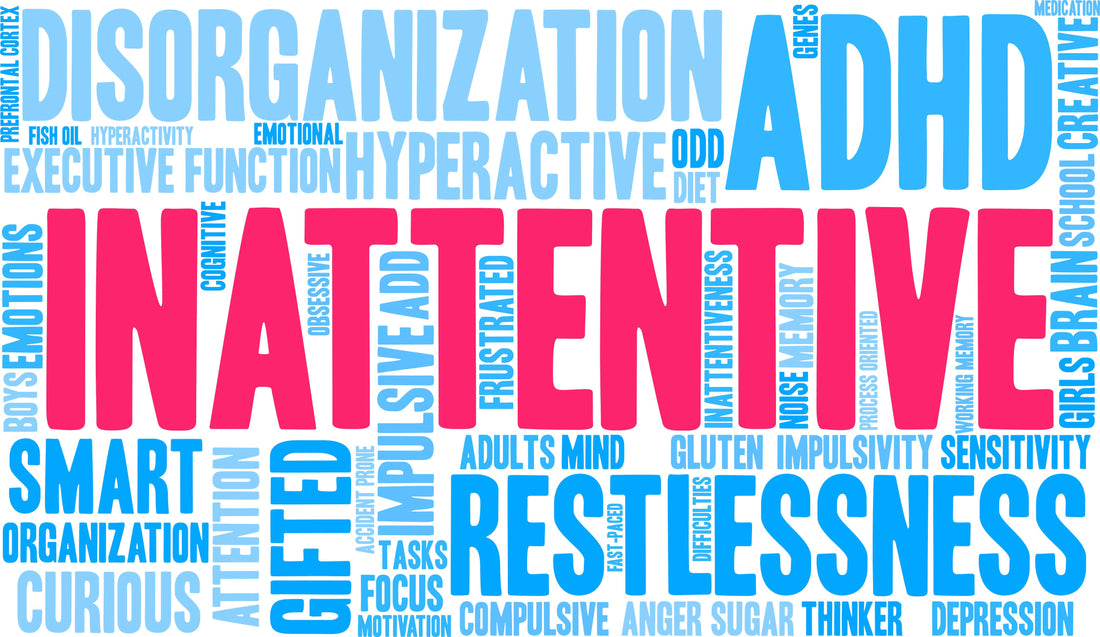From forgetting to pay a bill on time to being easily distracted, symptoms of inattentive ADHD in adults can lead to many challenges at work and at home. This is especially true for individuals who were not diagnosed until later in life, or ever. ADHD in girls and women is typically missed because their symptoms are not as obvious compared to those with hyperactive ADHD. Find out how inattentive ADHD manifests in adults, signs and symptoms to monitor, and treatment options that are available.
What Is Inattentive ADHD?
According to the American Psychiatric Association, there are three types of ADHD: inattentive type, hyperactive-impulsive type, or combined (in which inattentive and hyperactive-impulsive symptoms are both present).1 People with inattentive ADHD often have trouble paying attention to details, are easily distracted, have difficulty completing tasks, and often forget routine chores like paying a bill on time or keeping appointments. Girls and women are more likely to present with inattentive ADHD, rather than the hyperactive-impulsive type.
Though the causes of inattentive ADHD are unclear, some experts believe that genetics or the environment may be involved. Most adults with inattentive ADHD developed the condition in childhood, though their symptoms may have been written off as “daydreaming” or “laziness.” Adult ADHD is often misdiagnosed as depression or anxiety, though these mood disorders can also co-exist with ADHD.
How Inattentive ADHD Is Diagnosed
According to the CDC, for Inattentive ADHD to be diagnosed in adults, five or more symptoms must be present for at least six months.2 While inattention can happen to anyone from time to time, for the person with inattentive ADHD, their symptoms interfere with their quality of life at work, home, or socially. While there is no specified genetic or medical test to diagnose inattentive ADHD, a qualified health professional should be able to diagnose after a thorough evaluation. This may include ruling out another disorder that may be causing the symptoms.
Signs & Symptoms
The Cleveland Clinic reports that there are nine symptoms associated with inattention to meet diagnostic criteria.3 These symptoms include:
- Difficulty staying focused on tasks at work or at home; becoming bored quickly
- Tendency to miss important details, often resulting in mistakes
- Trouble with organization, such as staying on top of deadlines or keeping a tidy work space
- Distractibility
- Failure to complete tasks or follow directions
- Forgetfulness
- Avoidance of tasks that require persistent focus
- Tendency to misplace things
- Inability to listen, even when spoken to directly
Treatment Options
Some people choose to treat inattentive ADHD with prescription medications, such as psychostimulants, antidepressants, and nonstimulant drugs. These drugs affect neurotransmitters in the brain and stimulate the central nervous system to improve attention and focus. While these drugs may reduce symptoms of ADHD for some, they do come with a variety of unfavorable side effects, such as insomnia, decreased appetite, headaches, and mood changes. Some ADHD medication may also mask the personality, making a user appear quiet or withdrawn.
Other people seek out a trained therapist, such as a cognitive behavioral therapist. In cognitive behavior therapy (CBT), therapists work with patients to identify problem behaviors and co-create helpful strategies to self-regulate. Strategies a therapist may suggest to a person with inattentive ADHD may be using a planner to stay organized, placing clocks all around the house to keep track of time, or learning how to prioritize tasks.
Another option for reducing symptoms of inattentive ADHD is to take a non-prescription medication like Brillia. This targeted homeopathic remedy regulates the activity of the S100B protein, which is involved in a number of cellular processes, including neuroplasticity. When the S100B protein is out of balance in the body, it contributes to common symptoms of ADHD such as lack of focus and irritability. The active ingredient in Brillia consists of antibodies to the S100B protein. It functions by attaching to the protein and changing its activity, reducing ADHD symptoms at the source. This process is highly efficient and produces no harmful side effects for the user. The medication does not cause drowsiness, lethargy, depression, nor does it mask the personality or affect the appetite, which would otherwise result in weight gain or weight loss. There is also no “coming off” Brillia, so if you decide to stop taking it or simply take a break, you won’t experience unfavorable side effects. Brillia also has no contraindications with other supplements or medications so you can add it to your regimen without worry. The medication works best in combination with healthy lifestyle factors, such as eating nutritious food, sleeping well, controlling one’s screen time, and practicing mindfulness. This holistic approach ensures that users are addressing their ADHD symptoms from multiple vantage points.
Tips on How to Deal With Inattentive ADHD
Beyond taking medication, seeing a therapist, and investing in a healthy lifestyle, there are a number of easy ways you can start improving your focus and attention. Here are some tips that may help if you have inattentive ADHD:
- Get in the habit of taking notes and writing lists and hang your to-do list in a place where you can see it frequently
- Use a calendar app or day planner
- Establish an overall daily routine
- Designate specific areas for everyday items like keys or wallet and keep non-everyday items in storage bins or closets to minimize clutter
- Resist the urge to procrastinate on small tasks, which build up over time
- Set up a filing system for important documents or digitize them
- Use clocks and timers
- Overestimate how long a task might take
- Avoid the urge to multi-task
- When working, use noise-cancelling headphones or listen to music to filter out external noise
- Switch to online banking and sign up for automatic bill-pays
- Practice self-care, such as exercising, prioritizing sleep, and sticking to a healthy diet
Find more resources on managing ADHD symptoms on the Brillia blog.


 Improve focus and clarity.
Improve focus and clarity.


